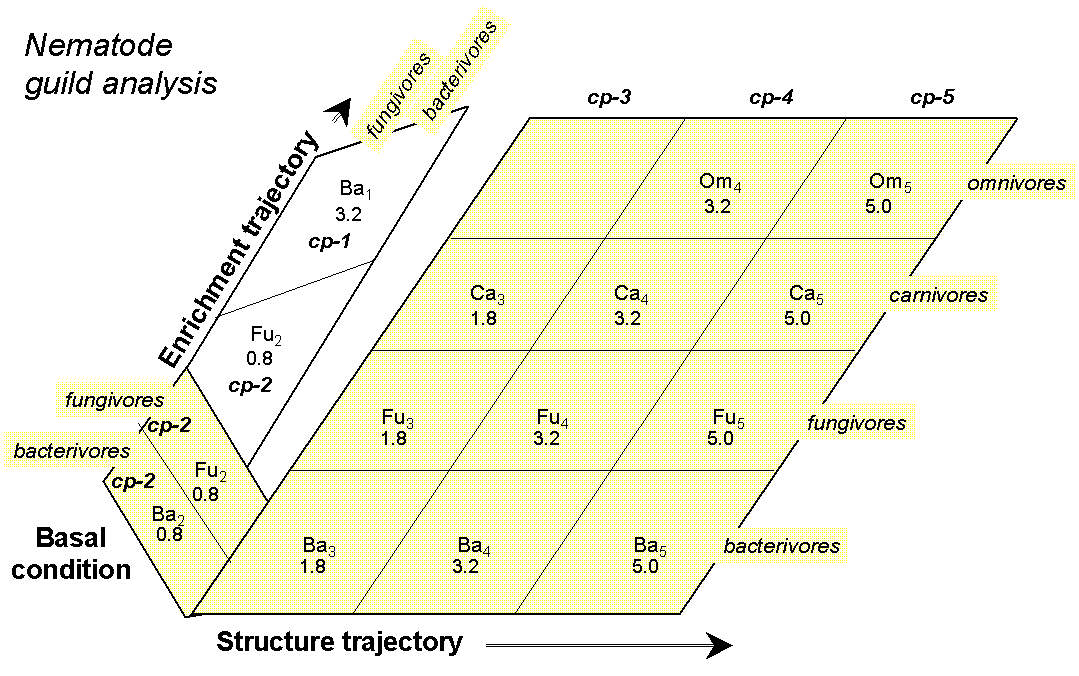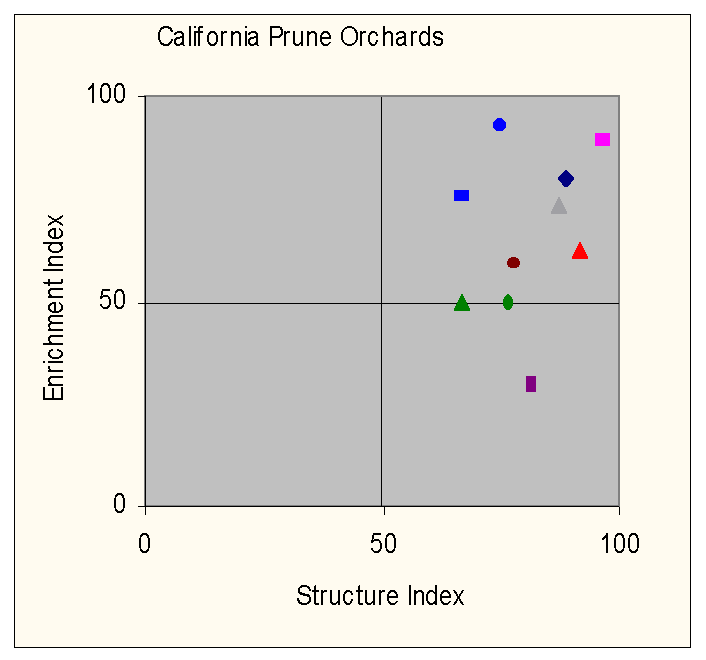
Nematology 100 Laboratory Project
Fall Quarter, 2012
Nematode Collections and Soil Nematode Faunal Analysis
During the quarter you will learn to recognize many different genera and species of plant-parasitic nematodes. While these nematodes are important pests in agroecosystems, there are many other nematodes in the soil that play important functional roles in the biology of soils. These "free-living" nematodes are part of the soil food web and behave as bacterivores, fungivores, omnivores and predators at various trophic levels. Some participate in nutrient cycling and mineralization; others may regulate the abundance of organisms at lower trophic levels.
Nematode faunae of different ecosystems vary in the presence, abundance and proportion of various taxa. Valuable information regarding soil processes and health and, we think, the status of the soil food web, can be obtained simply by taking a soil sample, identifying and counting the nematodes present, and analyzing the data collected.
Objectives:
Assignment:
A. Weekly CollectionsB. Faunal Analysis Project

Fig. 1. Functional guilds of soil nematodes characterized by feeding habit (trophic group) and by life history characteristics expressed along a colonizer-persister (cp) scale (after Bongers and Bongers 1998). Indicator guilds of soil food web condition (basal, structured, enriched) are designated and weightings of the guilds along the structure and enrichment trajectories are provided.
c. Use the Nematode Faunal Analyzer software in Nemaplex to determine the "enrichment status" of the soil environment, the degree of "trophic connectance" in the soil food web and the paths of carbon and energy flow through the food web.
Select Nematode
Ecology from the Nemaplex Main Menu
Then Nematode Faunal Analysis
Then
Nematode Faunal Analyzer Spreadsheet.
There you will see how the data you record in the table below are used.

Fig. 2. Status of the soil food web, as indicated by nematode faunal analysis, in ten northern California prune orchards.
References
Bongers, T., and M. Bongers, 1998. Functional diversity of nematodes. Appl. Soil Ecol. 10, 239-251.
Ferris, H., T. Bongers, and R. G. M. de Goede. 2001. A framework for soil food web diagnostics: extension of the nematode faunal analysis concept. Applied Soil Ecology 18:13-29.
Nemaplex – Nematode
Ecology – Nematode Faunal Analysis
| FunctGld | Functional | c-p | Enter Your | Representative | Basal | Enrich. | Structure |
| Code | Guild | value | Data Here | Families | Wtg | Wtg | Wtg |
| b1 | Enrichment Indicator Bacterial Feeders - Active Stages | 1 | Rhabditidae, Diplogastridae, Panagrolaimidae | 0 | 3.2 | 0 | |
| Dauer Stage of Enrichment Indicators | 1 | Rhabditidae | 0 | 0 | 0 | ||
| b2 | Basal Indicator Bacterial Feeders | 2 | Cephalobidae, Plectidae | 0.8 | 0 | 0 | |
| b3 | Bacterivores | 3 | Prismatolaimidae, Teratocephalidae | 0 | 0 | 1.8 | |
| b4 | Bacterivores | 4 | Amphidelidae, Alaimidae | 0 | 0 | 3.2 | |
| b5 | Bacterivores | 5 | Isolaimiidae | 0 | 0 | 5 | |
| f2 | Enrichment and Basal Fungal Feeders | 2 | Aphelenchidae, Aphelenchoididae | 0.8 | 0.8 | 0 | |
| f3 | Fungivores | 3 | Diphtherophoridae | 0 | 0 | 1.8 | |
| f4 | Complex Fungivores | 4 | Leptonchidae | 0 | 0 | 3.2 | |
| p1 | Opportunistic Predators | 1 | Neodiplogastridae | 0 | 3.2 | 0 | |
| p2 | Apehelenchoid Predators | 2 | Aphelenchoididae | 0.8 | 0 | 0 | |
| p3 | Small Specialist Predators | 3 | Tripylidae | 0 | 0 | 1.8 | |
| p4 | Large Specialist Predators | 4 | Mononchidae | 0 | 0 | 3.2 | |
| p5 | Large dorylaimid Predators | 5 | Discolaimidae | 0 | 0 | 5 | |
| o4 | Small Omnivorous Generalist Predators | 4 | Dorylaimidae, Qudsianematidae | 0 | 0 | 3.2 | |
| o5 | Large Omnivorous Generalist Predators | 5 | Aporcelaimidae | 0 | 0 | 5 | |
| Total Nematodes in Sample |
| FunctGld | Herbivore | |||
| Code | Plant-feeders: | Number | Representative Types | Wtg. |
| h2a | Root Associates; root hair/surface feeders | Tylenchidae | 0.8 | |
| h2 | Migratory Ecto/Endoparasites of stems, bulbs, leaves | Anguinidae | 0.8 | |
| h3 | Migratory Ectoparasites: Criconematoidea; cortex feeders | Ring, sheath, pin nematodes | 1.8 | |
| h3 | Migratory Ectoparasites: Tylenchoidea; short-stylets, epidermal feeders | Stunt nematodes | 1.8 | |
| h3 | Migratory Ectoparasites: Tylenchoidea; long stylets, root tip and deep feeders | Sting, awl nematodes | 1.8 | |
| h4 | Migratory Ectoparasites: Triplonchida; curved spear, root tip feeders | Stubby root | 3.2 | |
| h5 | Migratory Ectoparasites: Dorylaimida; long spears, root tip feeders | Dagger, needle | 5 | |
| h3 | Migratory Endoparasites: Tylenchoidea | Lance, spiral, lesion, burrowing | 1.8 | |
| h3s | Sedentary semiendoparasites: Tylenchida | Citrus, reniform | 1.8 | |
| h3s | Sedentary endoparasites: Tylenchina | Root knot, cyst | 1.8 |